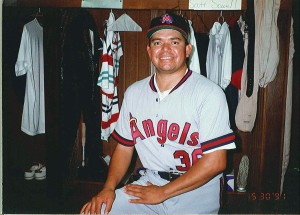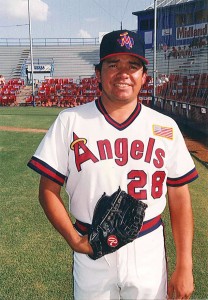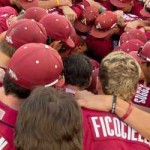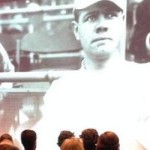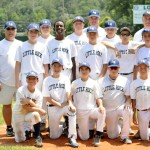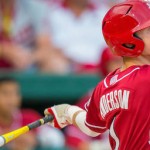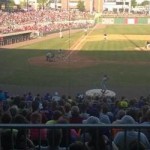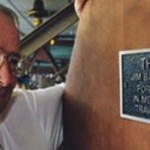For former major league superstar Fernando Valenzuela, it was another evening in another ballpark that today he can hardly recall. But for most of the fans who watched him pitch against the Arkansas Travelers, it’s a night that can never be forgotten.
A record 12, 246 fans jammed into Ray Winder Field on June 1, 1991 to watch Valenzuela, who in 1981 had become the first person to win a Cy Young award and Rookie of the Year honors in the same year, work his way back into the majors. After a ten-year stint with the Los Angeles Dodgers, Valenzuela had been released in March 1991. That May, he signed a one-year contract with the California Angels, who started him off with their single A minor league affiliate Palm Springs, Calif., to help him rehabilitate his injured shoulder.
It was assumed he’d stay in the West, closer to his home and where the Angels also had a AAA minor league team. Monty Hoppel, general manager of Midland, the Angels’ AA team, didn’t expect Valenzuela to end up in Texas: “Midland was kind of out of the way. We would very rarely get players like that on rehab because it’s convenience for the west coast teams to keep them single-A or triple-A.”
Valenzuela pitched one game in California on May 22 before being assigned to Midland. “We were very excited,” Hoppel recalls. Unfortunately, for the RockHounds, the left-handed, six-time All-Star joined Midland for a road trip and wasn’t scheduled to play at their home park. “We were very disappointed,” Hoppel says. “It was nothing the Angels did. It was just bad timing.” A bad turn of fortune for Midland turned out to be the best of luck for Arkansas.
Valenzuela started this Texas League stint in Jackson, Miss., where he threw 91 pitches but showed control problems in the first inning by allowing a walk with the bases loaded.
Arkansas came next on Midland’s schedule but it was not set he’d make the trip to Little Rock until a couple days before, longtime Travelers GM Bill Valentine recalls.
“Everybody knew who he was and he was gonna come here and pitch?” Valentine says. “It was a big deal.”
Not only was a marquee name on tap for the first game of a Saturday night doubleheader, but so was an appearance by Captain Dynamite, a stuntman who twice a year visited Ray Winder to lock himself in a casket with four sticks of dynamite and appear to blow himself up. Add to those attractions the fact that thousands of free promo tickets were already in circulation and an evening forecasted to be perfect for baseball watching – 85 degrees and 70% humidity – had all the makings of a box-office bonanza in place.
Valentine expected more people than Ray Winder’s 6,622 seats could hold. Nobody expected the number of fans who actually came.
The night’s historic nature was evident early. The Associated Press assigned its Little Rock bureau reporter Harry King to cover the Saturday game. “I don’t think we had ever staffed a Travelers game, even when they got to making the playoffs or something,” King recalls. “That was unusual to even think about going to Ray Winder for a ballgame.”
People started arriving at 3 p.m., three hours before the game’s start.
“We had a line of people clear down to War Memorial Stadium,” Valentine says. “I could see right away that we were in trouble. So I had [park superintendent] Greg Johnston go out in the outfield and put up flags all around the warning track and in foul territory all the way down to the start of the infield and on the other side in foul territory a few feet off the line all the way down to the infield.”
“More than 500 fans decided that only a choice seat would do and began gathering at the ballpark shortly after 3 p.m., content to bake for two hours before being allowed to stampede into the park. Several groups occupied the dead time by setting up a picnic, a couple of industrious sorts even charcoaling steaks on portable grills on the Ray Winder parking lot. The Lakewood Optimist Club took advantage of the gathering to raffle off a bass boat at $2 a pop. It wasn’t a tailgate party on the same scale as the ones staged down the street at War Memorial Stadium, but it was an uncommonly festive scene. Kathy Colclasure of Maumelle, her 7-year-old daughter Cara, 13-year-old son Holland and 11-year-old family friend Chris Carter won the head-of-the-line honors, and by 3:15 were camped out on a large beach towel at the front gate.” Arkansas Gazette, June 2, 1991
Fans weren’t the only ones waiting to get in.
Valenzuela, who’d flown in from California for the game, was initially denied admission to the stadium parking lot, according to the game report by John Needham of the Los Angeles Times.
Not until an attendant carefully checked his picture I.D. and determined he was indeed one of the players was the Mexican 30-year-old allowed to enter.
Even then, there was still an identity issue.
Later in the afternoon, around the start of the game, “Midland pitcher Mark Zappelli borrowed Valenzuela’s jersey and stepped to the top of the Angels’ dugout, hoping to fake out autograph seekers,” according to an Arkansas Gazette account. “Zappelli’s stunt, however, was met only by boos from the fans.”
There was only applause, though, when the real Valenzuela walked out of the Midland dugout with his two-man police escort at 6:12 p.m.
Meanwhile, the ballpark was starting bust at its seams. Michael Schiff, then a Travelers intern, recalls the rush of people catching the staff off guard: “I don’t think they had an idea it would be as crazy as it was, and we just started going along with the flow, and Valentine just kept on selling tickets – even though we knew that there wasn’t room.”
Pretty soon, “You could not walk in the lobby,” Valentine adds. “The lobby was wall to wall people.”
Demand for food and drinks outstripped supply. Meredith Edwards worked concessions in the lobby that night. “For the most we probably kept up as best we could in such small quarters,” she says. “It was nothing compared to Dickey Stephens Park. It was just one long room, with a wall and dividers and a room to go into each section, but nothing compared to what we have now.”
Still, despite best efforts, “everything was behind,” Valentine recalls. “Beer stand was behind, hot dog, nachos, soft drinks. We were trying to scramble, getting everybody we could get.”
Makeshift concession stands started appearing on just about any patch of earth where a trundle of 12-packs could be dropped. Intern Michael Schiff sold from a metal cooler in a picnic area in left field. The third base bleachers blocked his view of Valenzuela but he didn’t have much free time to spend watching anyway. Fans bought Schiff’s soda faster than it could be restocked. “There was no more Pepsi or Diet Pepsi so people were buying Diet Orange Slice who probably never had Diet Orange Slice in their life.”
Schiff, then age 23 and all of three months into his internship, said his ability to turn a profit that night helped propel him a few weeks later into a job as Travelers assistant general manager. “My predecessor was not doing an exemplary job.”
Many of the fans who entered the ballpark that night got the unexpected bonus of a unique vantage point.
One fan, Charlie Hart, recalls buying general admission tickets and walking into the third base bleacher section. Soon after entering the area with about a dozen co-workers, “we were cattle called past 3rd base and on out to the left field area. They eventually found an area to stand on the warning track closer to center field, in a 10-foot wide area. They stood in front of an 8-foot tall green plywood fence and behind a line of little plastic flags that were supposed to keep fans from stepping onto the part of the outfield closer to the action.
Hart recalls one member of his party defied a policeman’s warnings by stepping anyway. Hart and his co-workers stayed in that area most of the game, watching, drinking beer and signing their names on an advertisement sign on the outfield wall.
Other fans just passed by.
“Now then, it just got to the point where we couldn’t let them in fast enough. So I went out to left field – we had a gate up high – and you could come into that gate if you had a free ticket,” Valentine says.
Fans flooded the outfield’s periphery, but some didn’t want to stand there for the whole game. They needed an exit. So Valentine opened a maintenance gate in right field that led to a parking lot.
Soon, traffic started flowing as fans entered the left gate. As Valentine recalls, “people would come in the big gate out there, walk down – it was strictly standing room only everywhere – and then slowly make their way around the ballpark, stopping then moving, stopping and moving, and watch [Valenzuela] pitch, and when they got to the first base side, a lot of them just left.”
It’s estimated 2,500 fans stood, at various times, in the warning track and foul areas to watch Valenzuela’s distinctive look-to-the-heavens windup and screwball pitch. B.J. Maack, then a Travelers clubhouse attendant, saw the spectacle unfold from the roof for a few innings because he couldn’t find any space in the stands beneath it: “I just remember thinking how odd it was thinking there were people lined up four or five deep in the outfield to watch a game.”
Valenzuela played better than he had in his previous two outings, throwing 47 strikes in 78 pitches. “I used all my stuff, and it was working fine,” he told the Los Angeles Times. He “initially relied on his fastball and then started mixing in more curves and screwballs to retire the side in order in four of the seven innings” while striking out five batters, according to the newspaper. “There were some boos and an occasional ‘You’re a has-been’ catcall, but there was more applause” as Midland marched its way to a 4-0 victory.
Tripp Cromer and Mike Fiore were the only Travelers to get hits off Valenzuela, who also walked two. During the game, the teams twice hit balls into the crowd on the field. Those counted as ground-rule doubles.
That season, Arkansas was the Texas League’s weakest-hitting team, so much of the blame for the lack of scoring goes there. But there may be another reason outside of Valenzuela’s pitching. Or, rather, behind it.
Reggie Temple, the Travelers’ longtime assistant park superintendent, recalls the fans on the field were originally not supposed to freely walk from left to right field. Standing on the warning track in the exact middle outfield, in direct line of vision of batters at plate, was verboten. Officials thought fans who stood there would distract the batters. But some fans still crossed to the other side. “They got hard-headed, anyway,” Temple says. “You know how they do.”
A few rogue fans caused a ruckus between the games:
“Fans from the foul areas and warning track rushed in toward the infield for Captain Dynamite’s act, but stadium announcer Bill Powell quickly urged fans to move back, that “‘This is real dynamite, understand?’” – Arkansas Gazette, June 2, 1991.
Even during that intermission, with Valenzuela’s night wrapped, fans were still arriving.
“Never ever have I witnessed a park as absolutely full of people,” Valentine says. “In fact, some people wrote letters to the editor, saying I had endangered people by having that many people in the facility at one time…”
Valentine didn’t think balls hit into the crowd or the possibility of fire made the situation especially dangerous. “We had six gates open, we had two of the huge gates that you drive vehicles through open in right and left. You could’ve gotten in and out. It wasn’t like they would have to go out in a single line or something.”
Valenzuela didn’t wait around long after pitching his game. Maack, the attendant, made sure to get a souvenir before he left. While Valenzuela iced his arm in the training room, Maack asked him to sign a ball. “He said ‘No problem. Glad to do it,’ Maack recalls. “I just remember him being nice about it.”
Soon after the icing, near the start of the second game, Valenzuela was quietly escorted to a waiting car in one of the less crowded areas outside. Valentine can’t recall if he was driven back the hotel or directly to the airport. Midland GM Monty Hoppel, who attended the game, can’t recall specifics either. Either way, it’s likely Valenzuela quickly flew back to his California home.
It was a quiet end to an outing that Valenzuela hoped would herald a return to the stratospheric heights he’d achieved in the early 1980s, when he won a World Series in that wondrous rookie season. Turns out, the Arkansas game didn’t signify much of a comeback at all. Valenzuela ended up going 0-2 with the Angels that summer before returning to Midland for a second AA stint. In his one home game there, he drew nearly 6,000 fans to a ballpark that sat around 4,500. Like in Little Rock, fans stood on the foul areas and warning tracks. “It was one of our biggest draws ever,” Hoppel says.
Valenzuela later played for four other MLB teams while dipping back into the minors and the Mexican League. He never could quite recapture the magic.
But, by his mere presence, he could still create it for those around him. The Travelers made $33,000 that evening in concessions, compared to a season average of $9,022, according to a 2003 Arkansas Democrat-Gazette article. And, Valentine recalls, “once we took a turnstile reading, we were absolutely flabbergasted.”
Why did so many people come to Ray Winder that night, although Valenzuela then was already many years past his prime? Some likely came to pay tribute to a cultural icon who’d once played so well, and with such passion, that they’d fallen deeper in love with a child’s game. Others simply came to plug into the electricity of the moment.
“Baseball was still king at that time,” Maack says. “I think there was a lot of people who sensed that this could be the final opportunity to see a legend. They thought, ‘You know it’s a free night. What else are we gonna do? Let’s say we were there.’”
In the last 22 years, football has become the sport with the largest drawing power in the U.S. while the popularity of basketball and soccer has also surged. Baseball’s popularity has dipped.
Valenzuela was one of the best out-of-state players to ever play against the Travelers. But who were the best out-of-state players to play for an Arkansan minor league team? The debate is tackled here.
Follow Evin Demirel, who often writes about Arkansas’ sports history, on Twitter.
The above article originally published in the Travelers’ “Baseball on Broadway” magazine for 2013.



